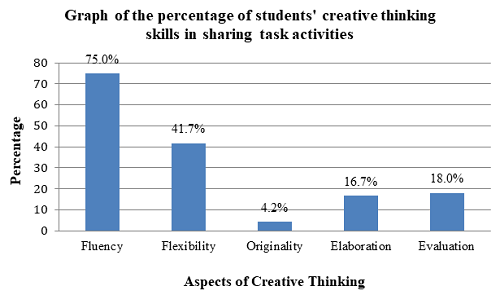
Implementation of Sharing & Jumping Tasks Learning to Grow Students' Creative Thinking Skills in Buffer Solution
Abstract
Keywords
Full Text:
PDFReferences
Aldig, E., & Arseven, A. (2017). The Contribution of Learning Outcomes for Listening to Creative Thinking Skills. Journal of Education and Learning, 6(3), 41–53.
Amabile, T. M., Collins, M., Conti, R., & Phillips, E. (1996). Creativity in context. Update to the social psychology of creativity. Boulder, Colorado. Westview Press Inc.
Arani, M. R. S. (2017). Raising the quality of teaching through kyouzai kenkyuu-the study of teaching materials. International Journal for Lesson and Learning Studies, 6(1), 10–26.
Barkley, E. F., Cross, K. P., & Major, C. H. (2014). Collaborative learning techniques: A handbook for college faculty. John Wiley & Sons.
Basarmak, U. (2019). The Effect of Digital Teaching Material (Public Service Ad) Development Process on Preservice Teachers’ Creative Thinking Skills. Malaysian Online Journal of Educational Technology, 7(4), 126–144.
Birgili, B. (2015). Creative and critical thinking skills in problem-based learning environments. Journal of Gifted Education and Creativity, 2(2), 71–80.
Cahyani, M. D. (2017). Pembelajaran kolaboratif sharing task dan jumping task pada topik rumus empiris dan rumus molekul berdasarkan hambatan belajar siswa dan refleksi diri guru. Universitas Pendidikan Indonesia.
Cenberci, S. (2018). The Investigation of the Creative Thinking Tendency of Prospective Mathematics Teachers in Terms of Different Variables. Journal of Education and Training Studies, 6(9), 78–85.
Damayanti, H. T., & Sumardi, S. (2018). Mathematical creative thinking ability of junior high school students in solving open-ended problem. Journal of Research and Advances in Mathematics Education, 3(1), 36–45.
Dillenbourg, P. (1999). Collaborative learning: Cognitive and computational approaches. advances in learning and instruction series. ERIC.
Eragamreddy, N. (2013). Teaching creative thinking skills. International Journal of English Language & Translation Studies, 1(2), 124–145.
Forrester, A., Sobester, A., & Keane, A. (2008). Engineering design via surrogate modelling: a practical guide. John Wiley & Sons.
Habibi, M., Jumadi, J., Gummah, S., Ahzan, S., & Prasetya, D. S. B. (2020). Project brief effects on creative thinking skills among low-ability pre-service physics teachers. Int. J. Eval. & Res. Educ. Vol, 9(2), 415–420.
Hadzigeorgiou, Y., Fokialis, P., & Kabouropoulou, M. (2012). Thinking about creativity in science education. Creative Education, 3(05), 603.
Hendayana, S., & Hidayat, A. (2013). Developing tools for analyzing of classroom interaction: Does it student-centered or teacher-centered lesson. Bandung: PPT Seminar International MSCEIS. UPI.
Johnson, D. W., & Johnson, F. P. (1991). Joining together: Group theory and group skills. Prentice-Hall, Inc.
Kacan, S. D. (2015). A situatıonal study for the identificatıon of pre-service science teachers’ creatıve thinking and creatıve scientıfıc thinkıng skills. Journal of Education and Practice, 6(27), 82–86.
Koray, Ö., & Köksal, M. S. (2009). The effect of creative and critical thinking based laboratory applications on creative and logical thinking abilities of prospective teachers. Asia-Pacific Forum on Science Learning & Teaching, 10(1).
Krulik, S., & Rudnick, J. A. (1995). The New Sourcebook for Teaching Reasoning and Problem Solving in Elementary School. A Longwood Professional Book. ERIC.
Kumdang, P., Kijkuakul, S., & Chaiyasith, W. C. (2018). An Action Research on Enhancing Grade 10 Student Creative Thinking Skills Using Argument-Driven Inquiry Model in the Topic of Chemical Environment. Journal of Science Learning, 2(1), 9–13.
Kutlu, N., & Gökdere, M. (2015). The effect of purdue model based science teaching on creative thinking. International Journal of Education and Research, 3(3), 589–600.
Munandar, U. (1992). Perkembangan kreativitas anak berbakat. Jakarta: Rineka Cipta.
Munandar, U. (1999). Perkembangan kreativitas anak berbakat. Jakarta: Rineka Cipta.
Northcott, B. (n.d.). Milliszewska., & Dakich, E. 2007. ICT for Inspiring Creative Thinking. Proceeding Ascilite Singapore.
Perdana, R., & Rudibyani, R. B. (2020). The Effectiveness of Inquiry Social Complexity to Improving Critical and Creative Thinking Skills of Senior High School Students. International Journal of Instruction, 13(4), 477–490.
Potur, A. A., & Barkul, O. (2009). Gender and creative thinking in education: A theoretical and experimental overview. A| Z ITU Journal of Faculty of Architecture, 6(2), 44–57.
Rahardjanto, A. (2019). Hybrid-PjBL: Learning Outcomes, Creative Thinking Skills, and Learning Motivation of Preservice Teacher. International Journal of Instruction, 12(2), 179–192.
Rajović, R., Gojkov-Rajić, A., & Stojanović, A. (2017). preschool teacher assessment of the NTC program reach: Encouraging creative elements of thinking. Istraživanja u Pedagogiji, 7(2), 265–282.
Risnawati, R., & Saadi, P. (2017). Meningkatkan Kemampuan Berpikir kReatif dan Hasil Belajar Melalui Model Pembelajaran Creative Problem Solving (CPS) pada Materi Larutan Penyangga. Quantum: Jurnal Inovasi Pendidikan Sains, 7(2), 127–134.
Sato, M. (2014). Presentasi Seminar Lesson Study. Universitas Pendidikan Indonesia, Bandung.
Sriwongchai, A., Jantharajit, N., & Chookhampaeng, S. (2015). Developing the Mathematics Learning Management Model for Improving Creative Thinking in Thailand. International Education Studies, 8(11), 77–87.
Sternberg, R. J. (2003). Creative thinking in the classroom. Scandinavian Journal of Educational Research, 47(3), 325–338.
Syahrin, A., SUWIGNYO, H., & PRIYATNI, E. T. (2019). Creative thinking patterns in student‘s scientific works. Eurasian Journal of Educational Research, 19(81), 21–36.
Tandiseru, S. R. (2015). The Effectiveness of Local Culture-Based Mathematical Heuristic-KR Learning towards Enhancing Student’s Creative Thinking Skill. Journal of Education and Practice, 6(12), 74–81.
Widiarta, I. P., Suastra, I. W., & Suswandi, I. (2017). Efektivitas Collaborative Learning Dalam Meningkatkan Kemampuan Berpikir Kreatif Siswa SMA. Jurnal Pendidikan Fisika Undiksha, 7(2), 204–213.
Wijaya, E. Y., Sudjimat, D. A., & Nyoto, A. (2016). Transformasi Pendidikan Abad 21 Sebagai Tuntutan. Jurnal Pendidikan, 1, 263–278.
DOI: http://dx.doi.org/10.31258/jes.6.1.p.11-23
Refbacks
- There are currently no refbacks.
Copyright (c) 2022 Witty Zestia, Asep Supriatna, Nahadi Nahadi

This work is licensed under a Creative Commons Attribution 4.0 International License.
Publisher: FKIP Universitas Riau













